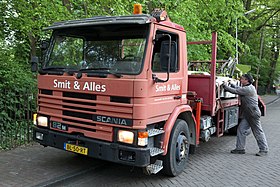Scania 2-series
| Scania Two-Series | |
|---|---|
 | |
| Overview | |
| Manufacturer | |
| Production | 1980–1989 |
| Assembly | |
| Designer | Italdesign Giugiaro[1] |
| Body and chassis | |
| Class | Heavy truck |
| Body style |
|
| Chronology | |
| Predecessor | Scania 1-series |
| Successor | Scania 3-series |
The Scania GPRT range, later known as the Scania 2-series, is a truck model range introduced in 1980 by Swedish truck manufacturer Scania.[2] It is the successor of the "1-series". The 2-series came in a range of different engine sizes and power ratings from 7.8 litres I6 to a 14.2-litre V8 engine. Production of the 2-series was stopped after the 3-series were introduced in 1987, but the production of the 2-series continued in Argentina and Brazil until 1992. The range was first shown in the spring of 1980 as the bonneted (conventional-cab) T-series (for "Torpedo", not to be confused with the 2004 T-series).[3] The cab, also featuring an all-new interior, was designed by Giorgetto Giugiaro.[1] The 2-series was also manufactured by Scania's Brazilian operations, beginning in 1982. In 1984, the 8.5-litre "92" series was added.[citation needed]
Letter suffixes M, H, or E, relate to frame/suspension ratings - "medium", "heavy", or "extra-heavy" duty.[1] Prefixes used are as follows:[4]
- G – rigidly mounted short, low cab
- P – suspended low cab, short or long (single berth)
- R – high cab, short or long (double berth)
- T – bonneted (conventional) cab, short or long (double berth)
Bonneted (conventional-cab) model (T)[edit]

At the time of introduction, the 2-series "T" was available with either a 7.8, 11.0, or 14.2-litre engine. These were denoted 82, 112, or 142.[1]
See also[edit]
References[edit]
- ^ a b c d Kennett, Pat (June 1980). "What's new: Sweden's gentle giant". TRUCK. London, UK: FF Publishing Ltd: 27.
- ^ "1980: Introducing the GPRT range". Scania AB. Retrieved 18 March 2016.
- ^ Kennett, p. 25
- ^ "Data key G range" (PDF). Scania. March 1987. Archived from the original (PDF) on 24 March 2016.
